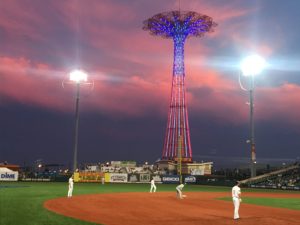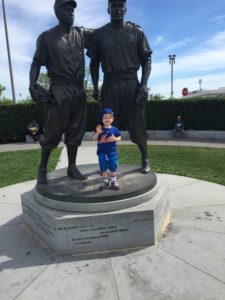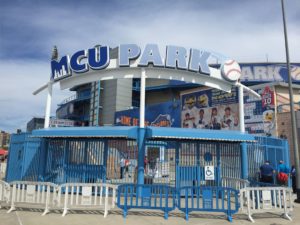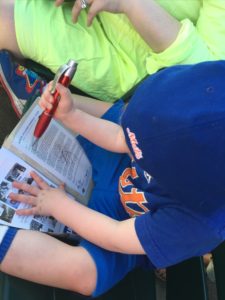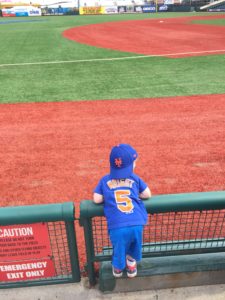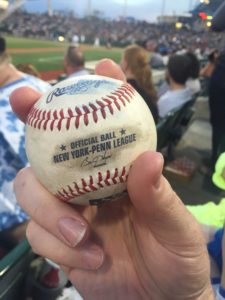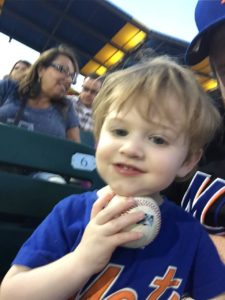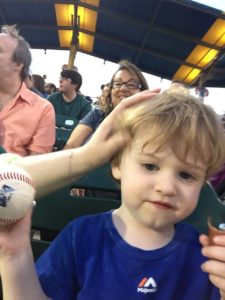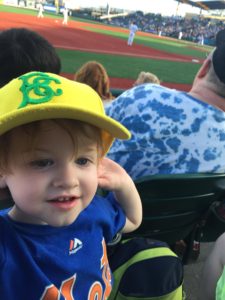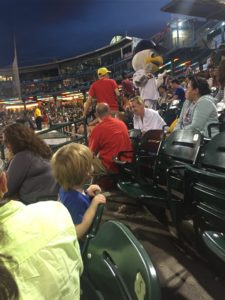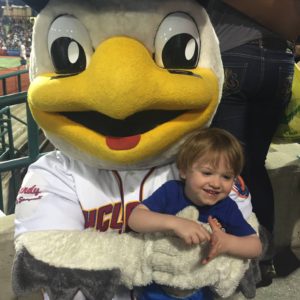Harol Gonzalez
With the collective bargaining agreement stalemate, and Commissioner Rob Manfred announcing the first two series of the Major League season will be canceled, minor league baseball appears to be set to be the only baseball left to be played. This was the case on August 12, 1994 until the end of that season, and right now, we don’t know how long it will be until MLB and the MLBPA reach an agreement.
This begs the question about how this will affect the minor league season. In many ways, the answer is not at all, but in a more global sense, it is a huge impact due to all of the uncertainty.
40 Man Roster Issues
First and foremost, this lockout impacts players on the 40 man roster. Keep in mind with Major League rosters being capped at 26 players, the 14 players who were supposed to play in the minors are now not permitted to play with their respective organizations.
This past offseason, the New York Mets added Mark Vientos, Ronny Mauricio, Adam Oller, and Jose Butto to their 40 man roster. They’re now not eligible to play in games or participate in Spring Training. The same goes for players like Travis Blankenhorn, Khalil Lee, Patrick Mazeika, and Nick Plummer who were likely ticketed for Triple-A to start the season.
Spring Training Battles
If we look back to the pandemic shortened season of 2020, MLB had a very abbreviated “Summer Camp” with players reporting on July 1 and beginning the season on July 24. In 1995, the strike and lockout meant Spring Training was delayed. When the two sides finally agreed to a deal, Spring Training was just three weeks. We’re very likely to see something akin to that again.
As a result, we are not going to have the opportunity to see Spring Training battles breath. At least at the moment, Tylor Megill and David Peterson appear poised to battle for the fifth starter spot. With no real Spring Training, and both pitchers being shut down because they are on the 40 man roster, it would appear the Mets would be all the more emboldened to sign another starter.
Speaking of Spring Training battles, there are those veterans who signed minor league deals. For example, this offseason the Mets signed Daniel Palka who has played 154 Major League games in his career and Matt Reynolds who has played 130 games. They would be permitted to play in Spring Training, where they would not be paid, and they can then report to play in Triple-A Syracuse regardless of the status of the CBA negotiations.
Rule 5 Draft
As noted, players not on the 40 man roster are permitted to participate in Spring Training, and they can begin their minor league seasons when they are slated to begin. That is an enormous benefit for players like Carlos Cortes, Brian Metoyer, and Hayden Senger. Each of these players were on the bubble for Rule 5 protection, and the Mets opted to expose them to the draft.
This means Cortes, Metoyer, and Senger will get to play and improve. That will also give teams an opportunity to get a better look at those three players in determining whether they should be selected in the Rule 5 draft. Of course, that also works in the inverse with the Mets getting a deeper look into players they might be targeting.
Keep in mind, there isn’t much precedent here for this. In 1994, because there was a strike but not a lockout, teams were able to proceed with their business as usual and hold the Rule 5 draft in December (even if it was delayed twice). For the 2020 season, the Rule 5 draft had already taken place in December 2019 because COVID-19 was not yet a concern.
Another important note here is as MLB cancels games, it becomes easier to carry Rule 5 drafted players. As a result, the risk in selecting a Rule 5 player has been greatly mitigated. Another factor at play here is we may see players get drafted based on early season results who may not have been otherwise considered. To sum up, this is a quagmire.
Games
At the moment, the Mets have their minor league mini-camp. Minor League Spring Training is also set to officially begin this week. As of right now, according to their official schedule, the Mets are slated to play their first Spring Training game on March 12 against the St. Louis Cardinals.
Of course, games were supposed to begin February 28, but it was delayed due to the lockout. As of right now, there is no official word if games will be delayed further. That said, there will likely be some form of a Spring Training game schedule even absent a CBA being in place to allow the minor leaguers to prepare for their season. The season for the Mets full season affiliates are set to begin as follows:
- Syracuse Mets – April 5
- Binghamton Rumble Ponies – April 8
- Brooklyn Cyclones – April 8
- St. Lucie Mets – April 8
For those Mets fans who want to attend a baseball game, the Brooklyn Cyclones home opener will be on April 12 at 7:00 P.M. against the Jersey Shore Blue Claws (Phillies).
Coaching
Right now, the Mets are paying Buck Showalter a lot of money to manage a team which is not set to play. That leaves Showalter with the job of preparing to prepare for the season. In some ways, that’s extremely beneficial for the new staff with new coaches like Eric Chavez to come to work together.
It also gives them an opportunity to work with the minor leaguers in Spring Training, and perhaps, depending on the length of the lockout, to travel to work with some of the minor leaguers. This presents an enormous opportunity for players like Brett Baty, who is battling with Vientos for that future third base job. More than that, it allows some of the more unheralded prospects like a Harol Gonzalez to make an impression in camp and get an advocate from the Major League coaching staff in their corner.
That just speaks to just how different everything will be for minor leaugers. Yes, the players not on the 40 man roster will have no change to their schedule. They will report to Spring Training at the same time, and they will play the games like they normally do.
However, they will also get more exposure to Major League coaching, and they have more of an opportunity to distinguish themselves. Moreover, they will get to prepare for their season and work on their games while fellow minor leaugers who are on the 40 man roster will be at home unpaid and without a chance to work with their coaches to improve their game.
New York Mets prospect Harol Gonzalez was given the ball to kick off the Mets first Spring Training game of the year. In his one inning of work, he retired the Miami Marlins in order. He threw seven of his 10 pitches for strikes, and he struck out Jesus Aguilar.
From what we saw and have seen of Gonzalez, this may not be the last time we see him pitch with the Mets this season.
Gonzalez, 25, has never been considered a top prospect in the Mets organization. He’s relatively diminutive at 6’0″ (if he’s that tall), and he doesn’t have over-powering stuff. He was not even looked at in Rule 5 drafts, and he returned to the Mets organization after hitting minor league free agency.
Despite all of this, Gonzalez has worked his way through the Mets organization because he knows how to pitch. It’s that ability which has not only gotten Gonzalez to Triple-A before the pandemic, but it’s also what can get him to the majors.
In 2019, Gonzalez might’ve been his most impressive. With Binghamton, he was a minor league pitcher of the week and an All-Star. This led to his promotion to Syracuse.
With Syracuse, Gonzalez pitched very well. Over seven starts and one relief appearance, he was 6-0 with a 2.68 ERA, 1.066 WHIP, 2.2 BB/9, and a 5.1 K/9. Most of these numbers were aligned with his previous minor league stats with the exception of strikeouts which were on the low side.
Back then, Gonzalez was a pitcher who didn’t have plus stuff. All of his offerings were good, and he got the most out of them because he could locate very well while also being comfortable throwing any of his four pitches any time in the count.
That led to some awkward at-bats, and it did help Gonzalez limit the batters ability to square it up against him. That alone was reason to believe he could have an impact at the Major League level.
That said, he seems to have turned a corner, and as reported by SNY‘s Jacob Resnick, Gonzalez has increased velocity:
#Mets RHP prospect Harol Gonzalez will get the start in today's spring opener.
Once a finesse guy, he's now touching 95-96 and sitting 92-94, spotting it well up in the zone. Throws a CH, slow CB, and high 80s SL.
Mets rarely bring back their MiLB FA. Big move to keep him. pic.twitter.com/w3cXrD1ft2
— Jacob Resnick (@Jacob_Resnick) March 1, 2021
Gonzalez moving from the low 90s to the mid 90s is a game changer. That raises his ceiling, and it could be an indication the Mets may really have something with him, and we very well may see it at Citi Field in 2021.
This is like the Benjamin Button of minor leaguers. Most pitchers come in the minors with the raw stuff, and they have to learn to pitch. Gonzalez knew how to pitch, and now, his stuff is developing with his prime seasons a year or two away.
This isn’t all that unprecedented. We see this with Jacob deGrom (no, no one is comparing Gonzalez to deGrom). With increased access to better technology and better coaching as a pitcher works his way through the system, he can find that extra velocity and spin.
We may well be seeing that with Gonzalez now. We’re seeing a prospect who already knows how to pitch learn how to throw harder and better. That’s a very significant development not just for him, but also for the Mets system as a whole.
There may well be pitchers ahead of him on the depth chart, but if Gonzalez is spotting mid 90s fastballs on the corners and mixing it with good changes, curves, and sliders, he’s going to force his way to the majors.
Hopefully, we will see that happen.
The New York Mets did the obvious and added Andres Gimenez and Thomas Szapucki to the 40 man roster to protect them from the Rule 5 Draft. With the team potentially losing Tomas Nido as they investigate backup catching options, they secured their catching depth by adding Ali Sanchez. Finally, they arguably protected their best exposed starter in Jordan Humphreys.
Even with the Mets protecting these players, the organization is in real risk of losing some players in the Rule 5 Draft. In fact, you can see the Mets losing at least one player and possibly more. Here is a look the players the Mets may well lose in the order of likelihood of it happening:
Ryder Ryan, RP
Level: Binghamton
Stats: 3-1, 3.05 ERA, 25 G, 2 GS, 44.1 IP, 1.263 WHIP, 4.7 BB/9, 8.1 K/9
Ryan was the Mets return from the Jay Bruce trade with the Indians. He has a mid 90s fastball which can hit as high as 97 MPH, and he has a good slider. The two pitches can produce swings and misses, and when batters make contact, they hit the ball into the ground.
Ryan’s big issue has been control. That is partially due to his being a converted pitcher and also partially to his movement being difficult to him to harness. He made significant progress on that front in 2018 only to completely regress last year. If a team believes they can harness that, they will assuredly draft him.
Matt Blackham, RP
Level: Binghamton & Syracuse
Stats: 8-2, 2.60 ERA, 40 G, 55.1 IP, 1.066 WHIP, 4.6 BB/9, 11.4 K/9
In some ways, Blackham is very much like Ryan in that he is a reliever who can post high strikeout numbers, but he really struggles with control. However, whereas Ryan profiles as a future Major League reliever with his being 6’2″ and his ability to throw it in the high 90s, Blackham is only 5’11” and throws it in the low 90s.
Even with his throwing it in the low 90s, he generates a lot of strikeouts. In fact, he struck out 13.4 batters per nine in Binghamton. However, it should be noted that number dropped to 6.3 in 12 appearances for Syracuse. Still, with the movement he has on his fastball coupled with good breaking pitches. It’s very possible he is a pitcher who makes it to the Majors in 2020, but right now, the question is what uniform he will be wearing.
Shervyen Newton, INF
Level: Columbia
Stats: .209/.283/.330, 15 2B, 2 3B, 9 HR, 32 RBI, SB, 4 CS
With a good 2019 season, Newton might’ve forced the Mets hands. However, Newton had an injury plagued season and struggled mightily and his somewhat troubling strikeout rate worsened. Still, looking through it, Newton is a very promising prospect with promising power, athleticism, good instincts, and a born leader.
In a normal year, Newton would almost be guaranteed to go undrafted. However, with Major League Baseball adding an additional roster space, teams may opt to use that spot to stow a promising prospect like Newton. That goes double for American League teams who may not need to go so deep into the bench for a game. More than one person has surmised the Tigers could very well take this gamble.
Patrick Mazeika, C
Level: Binghamton
Stats: .245/.312/.426, 25 2B, 3B, 16 HR, 69 RBI, SB
On the subject of the 26th man, it will be interesting to see how teams use it in 2020. Some may use it to stash a Rule 5 prospect, and some may use it to carry an extra reliever or a catcher. If they are so inclined to carry an extra catcher, Mazeika is an interesting candidate.
Mazeika has a promising power bat, and he typically hits for more power when he is not catching everyday. While his stats in Binghamton don’t necessary prove that out, especially with him repeating the level, he did have a 118 wRC+with an above-average .182 ISO.
While there have been knocks on his catching ability, he has made significant strides. His framing has been overlooked, and he does his part controlling the running game. This is an area of his game he constantly works on and he makes strides forward each and every year. It’s possible a team sees that and wants him as their backup catcher.
Harol Gonzalez, RHP
Level: Binghamton & St. Lucie
Stats: 12-4, 3.01 ERA, 25 G, 23 GS, 137.2 IP, 1.082 WHIP, 2.2 BB/9, 7.3 K/9
The best way to describe Gonzalez is he is a pitcher who knows how to pitch. .He is a strike thrower who does not beat himself. He’s a four pitch pitcher without one outstanding pitch who thrives by mixing his pitches and locating them.
As the competition has improved through the minors, Gonzalez’s strikeout numbers have dipped, and yet he continues to be an effective pitcher. You could argue he has a future in the Majors as a long reliever or spot starter. His absolute ceiling could be fifth starter, but it is very questionable if he reaches that. Still, there is always room for a pitcher who knows how to pitch and can get outs. It will be interesting to see if some team finds that worthy of a Rule 5 pick.
Overall, the Mets arguably protected the right players. With the way the rules are designed, you cannot protect everyone. That leaves the Mets hoping the ones they did not protect will either go undrafted or be returned to the organization during the 2020 season. At the moment, that seems to be a long shot.
In the NHL draft tonight, the Vegas Golden Knights will be drafting players from each of the other 30 NHL rosters. There is a provision that players who have less than two years of service time are automatically protected thereby not making a team choose between a significant player and a huge prospect. It does beg the question about what would happen if that provision were removed.
Better yet, what would happen if teams were forced to protect just 10 of their best prospects in an effort to permit the new team to stock their minor league system. If the Mets were put in the position to select eleven players with under two years service time, who should they select?
1. SS Amed Rosario
By any account, Rosario is among the top prospects in all of baseball if not the top prospect. He has more than justified that billing this year. Through 69 games, Rosario is hitting .325/.368/.479 with 15 doubles, four triples, seven homers, 48 RBI, and 12 stolen bases. He’s great, and there is no circumstance in which the Mets should even think about losing him to another team.
2. 1B Dominic Smith
The Mets have been aggressive promoting their 2013 first round pick through the minor leagues. Last year, he was the youngest player in the Eastern League. This year, he has been among the youngest in the Pacific Coast League. Through it all, he has held his own, played a terrific defensive first base, and is developing power at every stop. He is the first baseman of the future for a team who will likely lose their current first baseman at the trade deadline or free agency.
3. RHP Justin Dunn
Last year’s first round pick has terrific stuff, and he showed it off last year. While he struggled this year, he has been better off for those struggles. Since being demoted to the bullpen to help him find himself, Dunn has gone 3-1 with a 0.86 ERA and an 8.1 K/9. When you have a player that struggles and improves this much, this is a player you make sure to keep.
4. RHP Robert Gsellman
Gsellman started last year pitching in Double-A, and he finished it helping pitch the Mets into the postseason. He’s had an up and down 2017 season, but he has shown flashes of his tremendous talent. He is just 23 years old, and he still has the stuff he did last year when he posted a 2.42 ERA in eight games. With a better infield behind him, which we should see with a Rosario promotion, we will likely see a return of the stats we saw last year.
5. SS Andres Gimenez
The 18 year old dominated the Gulf Coast League last year showing off his skill set that had him one of the highest regarded international free agent signings in 2015. He has skipped short season ball and held his own during his 37 games for the Columbia Fireflies. He has a good bat regardless of position.
6. LHP Thomas Szapucki
Szapucki is potentially a top of the rotation starter with a mid to high 90s fastball and a very good curve ball. He used that to be completely dominant in rookie ball. After an injury to start the year, he has just returned from the disabled list, and he is rounding into form.
7. CF Desmond Lindsay
The man dubbed as the “Offensive Machine” when he was drafted has certainly taken off lately. While he struggled to start the year, he has adjusted to the Sally League, and he has begun dominating. Since June began, he has been hitting .333/.400/.694 while playing a good center field. It seems he may have put his leg issues behind him, and he is taking the next step.
8. C Tomas Nido
After years of struggling at the plate, Nido broke out last year winning the Florida State League batting title. After a slow start to the season in Double-A, he is once again showing he is as complete a catcher as they come hitting .300/.353/.483 with 10 doubles, four homers, and 22 RBI in his last 32 games. He is proving last year was no fluke, and he is the Mets catcher of the future.
9. RHP Marcos Molina
Despite missing a year due to Tommy John surgery, the Mets believed enough in Molina to add him to the 40 man roster. They were right to do so. In five starts for St. Lucie, he was 2-3 with a 1.26 ERA, 0.767 WHIP, and a 7.2 K/9. That has earned him a promotion to Double-A and a clear path towards the major leagues.
10. RHP Seth Lugo
With spin rates, we know Lugo’s curve ball is the best in the majors. He has used that to help propel him not just to the majors, but also to have success in the majors. In addition to that, he has a fastball he can get into the upper 90s when he needs a big out. He used this repertoire to help pitch the Mets into the postseason last year. He has used it again this year to be effective in the rotation upon his return to the rotation from his elbow injury.
11. LHP Anthony Kay
The Mets have long wanted him. After failing to sign him out of high school in 2013, they made him their second first round draft pick last year. That is because he has a fastball he can get into the upper 90s with a promising curve ball and change. Like many college pitchers, his arm was abused by his coach, and he has suffered an injury requiring Tommy John surgery. He should be able to bounce back and be the pitcher the Mets have long thought he could be.
In the above list, the Mets have lots of pitching talent, but that would also leave a lot of pitching talent exposed. If the Mets went this route, they could lose a Harol Gonzalez or Jordan Humphreys, both of whom are having terrific years. There is also the potential position player cost. Brandon Nimmo and Gavin Cecchini are both former first round picks who are close to being regulars at the major league level.
Even if you were to make some amendments to the above list, you are still going to leave a very talented player exposed. This speaks to the depth of the Mets farm system that the Mets continue to improve with each draft and each international signing period.
With the full season minor leagues having their Opening Day on Thursday, the Mets have announced the rosters for each of their minor league affiliates. Each team includes an interesting group of prospects. Each team also features a particular strength of each aspect of the Mets farm system. Keeping in mind each particular group is viewed not just in terms of how good the players are now, but also how they project going forward, here are the best of the best:
Best Starting Pitching – St. Lucie Mets
Starting Rotation: Andrew Church, Justin Dunn, Marcos Molina, Nabil Crismatt, Kevin Canelon, Chase Ingram, Thomas McIlrath, Joe Shaw
The St. Lucie rotation features a number of pitchers who may very well make their way to a major league mound. The former second round draft pick Church fixed both his hip and his mechanics, and he had a breakout season last year. Dunn is already a top 10 Mets prospect a year after he was drafted. Molina is back from Tommy John surgery, and he has looked good in both the Arizona Fall Leauge and Spring Training. Crismatt more than held his own against the vaunted Dominican Republic team in the World Baseball Classic. This is as exciting a rotation as there is in the minor leauges, and possibly, you will see some version of this rotation with the Mets one day.
Honorable Mention: Columbia Fireflies. A rotation with Jordan Humphreys, Merandy Gonzalez, and Harol Gonzalez is a very interesting minor league rotation. It would have been more interesting with Thomas Szapucki, but he is slated to miss time due to a shoulder impingement.
Best Bullpen – Las Vegas 51s
Bullpen: Paul Sewald, David Roseboom, Ben Rowen, Beck Wheeler, Erik Goeddel, Chase Bradford)
The 51s bullpen features Sewald and Roseboom who were both extremely effective closers last season. Certainly, both impressed the Mets enough to get long looks during Spring Training. Prior to having bone spurs removed, Goeddle was an effective major league reliever. Rowen gives you a different look with his sidewinding action on the mound. Arguably, this could be a major league bullpen that could hold its own.
Honorable Mention: Binghamton Rumble Ponies. The Rumble Ponies bullpen has Corey Taylor, who has been favorable compared to Jeurys Familia, as its closer. There are some other interesting names like Ben Griset, who is a very promising LOOGY, and Luis Mateo, who was once a very well thought out prospect before he faced some injury issues.
Best Catching Tandem – Las Vegas 51s
Catchers: Kevin Plawecki, Xorge Carrillo, Jeff Glenn
If nothing else, Plawecki has established he can handle a major league starting staff. More to the point, Plawecki has shown himself to be a very good pitch framer. While his bat has lagged in the majors, at 26, he still has time to improve. Behind him is Carrillo, who is a good defensive catcher that won the Gold Glove in the Mexican Winter Leagues this past offseason.
Honorable Mention: Binghamton Rumble Ponies. Tomas Nido seemingly put it all together in St. Lucie last year, and he appears poised to take the mantle as the Mets catcher of the future. Binghamton very easily could have been named the top catching tandem off that, but some deference was paid to Plawecki showing he can handle the position defensively at the major league level.
Best Infield – Las Vegas 51s
Infield – 1B Dominic Smith, 2B Gavin Cecchini, 3B Phillip Evans, SS Amed Rosario
When the weak point of your infield is a player who is coming off a season where he won the Eastern League batting title, you know you have something special. Rosario and Smith are considered two of the best prospects not only at their positions, but in the entire game. Cecchini played well enough last year to be put on the 40 man roster a year ahead of schedule and earn a September call-up where he hit two doubles in six major league at-bats.
Honorable Mention: St. Lucie Mets. The team features a pair of 2016 draft picks in 1B Peter Alonso and SS Colby Woodmansee who showed real ability during their time in Brooklyn. Due to that success, they both skipped Columbia and joined an interesting second base prospect in Vinny Siena and a promising hitter at third base in Jhoan Urena.
Best Outfield – Columbia Fireflies
Outfield – Desmond Lindsay, Gene Cone, Jacob Zanon, Tim Tebow
No, this isn’t because of Tebow. This is mostly about Lindsay, who has been labeled as an “offensive machine” by the Mets organization. He is a five tool prospect that with a little health will arrive at Citi Field sooner rather than later. Another interesting five tool prospect is former Division II player Zanon. He certainly has all the tools to succeed. It is a question whether those tools can translate against better competition. Cone is a player who has a good baseball IQ, but he still needs to translate that and his talent to on the field success
Honorable Mention: Las Vegas 51s. The outfield got demonstratively better with the recent signing of Desmond Jennings. It will get better with either Brandon Nimmo or Michael Conforto playing for them again. That depends on Nimmo’s health as well as the health of the major league outfield. It will also be interesting to see how Matt Reynolds handles taking on what was Ty Kelly‘s role last year in being a utility player that mostly plays left field.
Overall, the Mets have a number of good to very good prospects who are either close or project to be major leaguers. Some of those players like Rosario will be stars. Others should have long major league careers. While we are getting excited for another year of Mets baseball, we also have a lot to be excited about for years to come with these prospects.
Like the Mets, the minor league affiliates’ seasons are long over, and over at Mets Minors, organizational leaderboards are being compiled, and awards are being handed out:
Full Season Batting Leaders – statistically speaking Brandon Nimmo might’ve had the best year especially with him missing out on the Pacific League batting title by .001 points and him having the top OBP in the farm system.
Short Season Batting Leaders – Despite having had the shortest season, Peter Alonso might’ve had the biggest impact
Minor League Best Starting Pitchers – Statistically speaking, the Mets best minor league pitchers were P.J. Conlon, Thomas Szapucki, Harol Gonzalez, Ricky Knapp, and Andrew Church.
Full Season Pitching Leaders – Naturally, the above-referenced pitchers were listed throughout.
Short Season Pitching Leaders – Gonzalez and Gary Cornish dominated for the Brooklyn Cyclones while Szapucki continued to show why he is becoming a big time prospect.
Here is how all the 2015 draft picks fared with Alonso and Justin Dunn as standouts. And nowadays, you would be remiss without mentioning the fact that Tim Tebow homered in his first professional at-bat.
However, here are the bigger awards everyone is most curious about:
Position Player of the Year – Amed Rosario with honorable mention to Dominic Smith
Pitcher of the Year – P.J. Conlon
Reliever of the Year – David Roseboom
As you saw this season, there were major contributors from the Mets minor league system this year. If not for Seth Lugo, Robert Gsellman, Josh Smoker, T.J. Rivera, and others, the Mets may not make the postseason this year. It is not only good to know the Mets minor league system has been this beneficial, but also that there is a significant amount of talent behind the players we have already seen contribute.
The Arizona Fall League is a showcase league where Major League teams have the opportunity to not only allow some of their prospects to refine their skills, but also to play in front of other team’s front office personnel. There are six teams total and teams play a 30 game schedule. Here is an in-depth look at who the Mets have assigned to the Scottsdale Scorpions:
Goodwin has been the Mets first base coach since the 2012 season. Goodwin is also responsible for the Mets outfielders and base running instruction.
Goodwin was named as the Scottsdale Scorpions manager leading a team comprised of Mets, Angels, Giants, Phillies, and Yankees minor leaguers.
The 22-year old Cecchini was the Mets 2012 First Round draft pick and is Mets Minors sixth ranked Mets prospect.
Cecchini was recently added to the Mets 40 man roster, and he was a September call-up.
With the emergence of Amed Rosario, Asdrubal Cabrera having another year on his contract, and Cecchini having defensive issues at shortstop, Cecchini started the transition to second base late in the AAA season. Presumably, Cecchini should see the bulk of his playing time at second base at the Arizona Fall League.
At the plate, Cecchini is a gap-to-gap line drive hitter who has steadily improved and hit for more power at each stop of his minor league career. Last season, his first season in AAA, Cecchini hit .325/.390/.448 with 27 doubles, two triples, eight homers, and 55 RBI.
In his brief playing time with the Mets, we saw a player who was ready to hit major league pitching with the ability to drive the ball into the gap. As he ages and continues to fill-out some of his doubles may eventually turn into home runs.
The 21-year old Molina was signed by the Mets in 2011 as a 17 year old international free agent out of the Dominican Republic. If he is not added to the 40-man roster, Molina will be eligible for the Rule 5 Draft.
When Molina takes the mound for the Scorpions, he will be throwing his first pitch in the 2016 season. After a rough start to the 2015 season, which was in part due to a torn UCL in his pitching elbow. Molina initially tried rest to deal with the injury. However, after three ill-fated and ill-advised outings in August, he would be shut down for the season, and he would undergo Tommy John surgery on October 31st.
Like with any pitcher returning from Tommy John, it is difficult to ascertain what he will be when he finally takes the mound. Prior to his injury, Molina was a pitcher with poor mechanics, which may or may not have attributed to his injury.
When healthy, he had a mid 90’s fastball with an advanced changeup and slider for his age. As noted, his mechanics are still raw, and a result, he has a tendency to change his arm angles on each pitch, which would obviously telegraph the pitch to more experienced hitters.
In his last healthy, season, he dominated in the New York Penn League making 12 starts going 7-3 with a 1.77 ERA, 0.84 WHIP, and 10.7 K/9. For a comparison, he had the type of year Harol Gonzalez had this year with similar stuff at a similar age. However, Gonzalez doesn’t have the mechanical issues Molina did.
The 25 year old Oberste was the Mets 2013 seventh round draft pick. If he is not added to the 40-man roster, Oberste will be eligible for the Rule 5 Draft.
Oberste is coming off a mediocre season for AA Binghamton. While he had appeared to make strides offensively and defensively last year in St. Lucie, he seemed to regress this season in both aspects. In the field, he does not have the range or the arm for third base. With that in mind, he is best suited for first base, where he has shown himself to be an adequate defender. The main issue there is Oberste does not have the bat to play first base.
In his four year professional career, Oberste has not hit for power as evidenced by his career .399 slugging percentage. While he has averaged 22 doubles over the past three years, he has yet to hit double digit homers. Oberste’s bat could justifiably play in the majors at second or a utility position. However, Oberste hasn’t shown the range to prove he could effectively handle either role.
On the bright side, Oberste did have a strong finish to his 2016 campaign. Over July and August, Oberste hit .305/.376/.455 with six doubles, two triples, five homers, and 28 RBI. Overall, Oberste hit .283/.340/.409 with 21 doubles, two triples, nine homers, and 54 RBI for the 2016 season. Obviously, he did most of his damage in July and August. He needs to carry forward what he did those two months into the Arizona Fall League and beyond.
Unlike the other Mets prospect, Nido is a taxi squad player meaning he is only available to play on Wednesday and Saturday. The 22-year old Nido was the Mets 2012 eighth round draft pick. If he is not added to the 40-man roster, Nido will be eligible for the Rule 5 Draft.
No one made a bigger leap in the Mets organization this season than Nido. When drafted, Nido was seen as a good defensive catcher with a strong arm. While he was seen as a player with some offensive promise with some power, that did not prove to be true in his first four major league seasons.
This year Nido put the full package together winning the Florida State League batting title. In 90 games, Nido hit .320/.357/.459 with 23 doubles, two triples, seven homers, and 46 RBI. Behind the plate, he continued to be a good receiver who threw out 42% of base stealers. Nido has a bright future ahead of him, and he appears to be the catcher of the future.
The 23-year old Oswalt was the Mets 2012 7th round draft pick. If he is not added to the 40-man roster, Oswalt will be eligible for the Rule 5 Draft.
Oswalt is a right-handed pitcher that once projected to be back-end rotation starter. However, Oswalt is being hampered by his mechanics and his inability to repeat his delivery. He was also hampered by his needing knee surgery back in 2013 which has slowed the former high school pitcher’s development. Another issue is Oswalt still has not developed his slider of changeup to the point where they can be an effective pitch for him.
Mostly, Oswalt relies upon a low 90s four-seam fastball and a high 80s two-seam fastball. With him mostly relying on those pitches, he made 13 starts and one relief appearance for St. Lucie going 4-2 with a 4.12 ERA, 1.34 WHIP, and a 9.0 K/9. If Oswalt is unable to develop his other pitches, he may be best suited to moving to the bullpen to see how well he could pitch putting maximum effort on his fastballs for an inning or two.
The 24-year old Roseboom was the Mets 2014 17th round draft pick. He was named Mets Minors Reliever of the Year.
The collegiate starter was immediately made a bullpen arm by the Mets organization despite his low 90s fastball. However, Roseboom was able to make a name for himself this season by not only combining that fastball with an effective slider and changeup, but also trust his stuff and pounding the strike zone.
Given his success, trades, and promotions, Roseboom found himself as the Binghamton Mets closer. As the B-Mets closer, Roseboom made 26 appearances converting 14 out of 15 saves. In that stretch, Roseboom had a 0.92 ERA and a 0.68 WHIP. Batters were only hitting .110 off of him. All season long, he showed the ability to get both righties and lefties out with righties hitting .189 off of him and lefties hitting .141 off of him. Ultimately, he is a platoon neutral left-hander who has the ability to pitch in high pressure and high leverage situations.
The 23-year old Stuart was the Mets 2013 sixth round draft pick. Another player that has to be added to the 40 this offseason to protect from the Rule 5 draft.
Stuart is an elite defensive outfielder that has speed on the bases as evidenced by him stealing 40 this season. The issue with Stuart is that he is a maddening offensive player. He went from hitting .265/.347/.407 in 71 games for Advanced A St. Lucie to hitting .201/.264/.261 in 43 games for AA Binghamton.
While Stuart has tremendous speed, he has not been able to use that speed to get extra base hits. This was the first season he has ever had double digit doubles, and he only had 12. While he has speed, he is still unable to take full advantage of it as he doesn’t hit the ball hard enough to turn singles into doubles and doubles into triples. Ultimately, while the Mets should be fully willing to see how far Stuart’s speed and glove will carry him, if he does not start hitting, he may never make it to the major leagues.
Taylor was the Mets 2015 17th round draft pick.
Taylor was a dominant collegiate reliever, and he has proven to be a dominant reliever in the low levels of the minor leagues. Taylor does it with a low 90s fastball and a still developing slider. Basically, he is your prototype of what you think is a Mets pitcher. While he has been working to develop a changeup, it is not yet at the point where it is a reliable pitch for him in games.
Taylor is successful because he uses his fastball to generate an almost inordinate amount of groundballs. In his minor league career, he has a 1.92 ground ball out to fly ball out ratio. Taylor used this pitch to help him have a successful season as the St. Lucie Mets closer. In 45 games, Taylor converted 20 out of 23 save opportunities. Overall, Taylor was 4-5 with a 1.87 ERA and a 1.25 WHIP.
Tim Tebow
As many people know, Tebow was signed by the Mets after he put on a showcase for major league teams. At the showcase, the one skill Tebow showed more than anything else was he had natural power. Everyone saw that power in effect when he hit a home run in his first ever professional at-bat in the Instructional Leagues.
Both Tebow’s proponents and detractors will say he is in the Arizona Fall League to boost attendance and revenues for the Arizona Fall League. As we have seen in Tebow’s NFL and very short baseball career, he attracts a crowd, and assuredly, much like Michael Jordan did back in 1994, he will bring record numbers to the ballpark.
If you are a proponent, you point out how this is a good thing because more revenue and attention is always good for baseball. Furthermore, it is a good thing because it will bring more attention to the players who are playing in the games.
If you are a detractor, you believe this is a bad thing because it is merely a distraction which creates a circus like atmosphere that is not conducive to the true intentions of the Arizona Fall League which is prospect development.
One way Tebow fuels his detractors is that he will get playing time that should have gone to another prospect. However, those 30 games isn’t going to change a team’s opinion on a player. Whether or not Tebow deserves to be on the roster, he is there.
In his short duration in the Instructional Leagues, he did show some ability to play baseball. Given his profile and, yes his marketability, the Mets have every interest in seeing how far he could go as a professional baseball player. The Arizona Fall League will help them in that assessment.
Tebow and the other Mets get their chance starting today as the Scottsdale Scorpions visit the Glendale Desert Dogs at 2:35 PM. Tebow will indeed be in the lineup today to make his AFL debut.
As of right now, there is no published TV schedule for any of the Arizona Fall League games.
Editor’s Note: this was first published on Mets Minors
On July 2nd, my family was able to attend a Brooklyn Cyclones game courtesy of Nicco Blank. With him getting called-up, he was able to leave us tickets to attend a Cyclones game while he left seats for Taylor Swift for the Columbia Fireflies game. Overall, it was a great experience, and my family is grateful that Blank was able to arrange for my family to get tickets to the game.
For those that have never attended a Cyclones game, MCU Park is located at the end of the Coney Island boardwalk.
The Original Nathan’s Famous is within walking distance if you want to get a pre-game meal, and you very well might as there is no outside food allowed in the boardwalk. Security does check. Also, it should be noted that most of the concessions located within the ballpark is cash only. It should also be noted that MCU Park charges major league prices at their concession stands. Once you have had your pregame meal, it is time to head over to the ballpark.
Right outside MCU Park is a statute of the moment where Pee Wee Reese put his arm around Jackie Robinson.
It is quite fitting this statue is in Brooklyn as this is the city in which Robinson broke baseball’s color barrier. The particular moment, whether or not it actually happened, is quite fitting as it symbolizes not just Robinson being accepted by his teammates, but also by all of baseball. This area is a good meeting spot and place to sit in the relative shade until the balllpark opens.
Similar to Citi Field, the ballpark opens an hour and a half before first pitch. Season ticket holders are given priority entrance, and once they are squared away, they will open the gates for general admission. Typicall, the promotion or theme night for that date will dictate whether or not there is much of a line outside the stadium. As we attended Seinfeld Night II, there was quite a line to get into the ballpark:
Other than these giveaways, the Cyclones hand-out programs to everyone that attends the game. For fans like me that like to keep score and buy the programs at games anyway, this is great. If you don’t have anything on hand and you want to get autographs, this works out great as the players can autograph either the cover or the inside where their player profiles are located. Finally, if you got to the game early and need to keep your toddler entertained, you can give it to him with the $4.00 pen he had to have from the gift shop to keep him entertained before first pitch:
Tickets to the ballpark range from $12.00 – $19.00, which would similar to the cost of Promenade seating at Citi Field. However, due to the fact that this is a minor league ballpark and there is only 7,000 seats, your seats are going to be much better than the seats you would get at Citi Field.
Fortunately, we were able to sit very close due to the generosity of Nicco Blank.
One of the benefits of being so close and being at a minor league park is you are close enough to get autographs seemingly no matter where you are sitting. Most, if not all of the players, are ready, willing and able to provide autographs. My son was quite fortunate as many Cyclones players, including Colby Woodmansee, Darryl Knight, Harol Gonzalez, Blake Tiberi, and others, signed my son’s Cyclones pennant. In particular, Knight stood out in his efforts to sign autographs for everyone despite the fact that his left arms was in a sling. Personally, I was hoping to snag an Edgardo Alfonzo autograph, but that was not in the cards for the day.
Another benefit is that since you are sitting close no matter where you sit, the chances are very likely that you are going to catch a foul ball. The one I caught was courtesy of Blake Tiberi:
I should mention that my son took all the credit for catching the ball (and yes, we did have the quick panic moment of him thinking about throwing the ball back onto the field):
I will say that it was nerve wracking at times being that close to the field with a two year old. While my son is good and will sit to watch a game, his attention span does wander at times because he wants to see what’s happening as all two year olds do. Considering how fast the foul balls were coming in, I did take some time to go around the ballpark to see if there were other things for my son to do.
Right outside the left field stands was a pitching game. For just $2, you were given three balls. If you were able to hit the catcher’s mitt, you were given a Cyclones hat:
Considering, I spent $4.00 on a pen, the $2 hat was a welcome surprise.
In addition to the Cyclones game and the pitching game, the other main attraction for the fans is Sandy the Seagull, who my son was just dying to meet:
Eventually, as the game ended Sandy made his way down to where we were sitting much to the excitement of my son:
Honestly, I’m not sure if this, winning the hat, or catching the foul ball was the highlight of the night for my son. But that’s the thing about attending a Cyclones game with your children – it’s a fun experience. Everyone, Taylor Swift included, should go out and see a Cyclones game to enjoy a great night at the ballpark. We enjoyed every minute of it, and we thankful to the Cyclones for creating such a family friendly atmosphere and to Nicco Blank for giving us the tickets.
